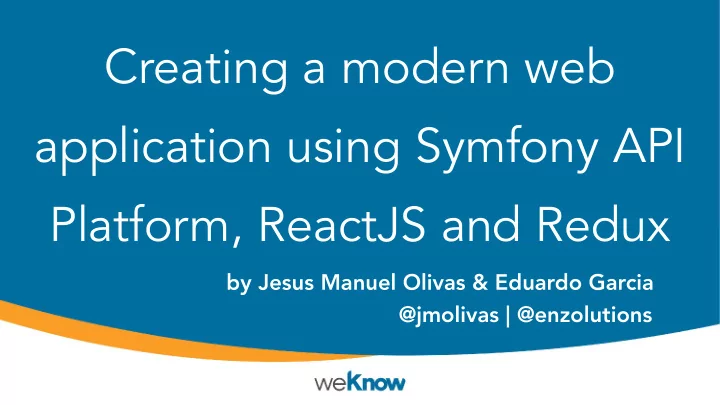

Creating a modern web application using Symfony API Platform, ReactJS and Redux by Jesus Manuel Olivas & Eduardo Garcia @jmolivas | @enzolutions
Who We Are? Jesus Manuel Olivas jmolivas@weknowinc.com jmolivas jmolivas http://drupal.org/u/jmolivas http://jmolivas.weknowinc.com
Who We Are? Eduardo Garcia enzo@weknowinc.com enzolutions enzolutions http://drupal.org/u/enzo http://enzolutions.com
WeGive
WeAre
WeKnow
Symfony API Platform / GraphQL ReactJS / Redux / Saga Ant Design
Symfony Flex
Symfony Flex … a Composer plugin for Symfony > Symfony Flex is a Composer plugin that modifies the behavior of the require , update , and remove composer commands. > Symfony Flex automates the most common tasks of Symfony applications, like installing and removing bundles and other dependencies using recipes defined in a manifest.json file.
Directory structure
API Platform Framework
The API Platform Framework REST and GraphQL framework to build modern API-driven projects https://api-platform.com/
Built on the Shoulders of Giants > Extend the framework with thousands of existing Symfony bundles and React components. > The API component includes the Symfony 4 flex, the Doctrine ORM . Client-side components and Admin based on React and a Docker configuration ready to startup your project using one single command. > Reuse all your Symfony , React and Docker skills and benefit of their high quality docs; you are in known territory.
The API Platform Components API Schema Admin CRUD
Try API-Platform # Clone code repository git clone https://github.com/api-platform/api-platform.git
Recommendations and adjustments > Update route prefix at api/config/routes/api_platform.yaml file. api_platform: … prefix: /api > Update admin/.env and client/.env files (change protocol and port). REACT_APP_API_ENTRYPOINT=http://localhost:8080/api
Start containers … and grab water, coffee, or a beer. # Start containers docker-compose up -d # Open browser open http://localhost/
Add more formats Update api/config/packages/api_platform.yaml adding: formats: jsonld: [‘application/ld+json'] # first one is the default format json: ['application/json'] jsonhal: ['application/hal+json'] xml: ['application/xml', 'text/xml'] yaml: ['application/x-yaml'] csv: ['text/csv'] html: ['text/html']
Add Blog and Tag entities, remove default Greeting entity > Add new entities to api/src/Entity/ directory: api/src/Entity/Post.php api/src/Entity/PostType.php api/src/Entity/User.php > Remove default entity api/src/Entity/Greeting.php
api/src/Entity/Post.php 1/3 <?php namespace App\Entity; use ApiPlatform\Core\Annotation\ApiResource; use Doctrine\ORM\Mapping as ORM; use Symfony\Component\Validator\Constraints as Assert; /** * @ ApiResource * @ORM\Table(name="post") * @ORM\Entity */ class Post { … }
api/src/Entity/Post.php 2/3 /** * @ORM\Id * @ORM\GeneratedValue(strategy="AUTO") * @ORM\Column(type="integer") */ private $id; /** * @ORM\Column * @Assert\NotBlank */ public $title = ''; /** * @ORM\Column * @Assert\NotBlank */ public $body = '';
api/src/Entity/Post.php 3/3 /** * @ORM\ManyToOne(targetEntity="PostType") * @ORM\JoinColumn(name="post_type_id", referencedColumnName="id", nullable=false) */ public $type; public function getId(): int { return $this->id; }
Tracking Database changes # Add dependency composer require doctrine/doctrine-migrations-bundle # Execute command(s) doctrine:migrations:diff doctrine:migrations:migrate
Add FOSUserBundle # Add dependency composer require friendsofsymfony/user-bundle composer require symfony/swiftmailer-bundle https://symfony.com/doc/current/bundles/FOSUserBundle/index.html https://jolicode.com/blog/do-not-use-fosuserbundle
Initialize the project > Drop and Create Database > Execute Migrations > Populate Entities with Data bin/console init NOTE: Use hautelook/AliceBundle or willdurand/BazingaFakerBundle
Loading Posts using the Browser http://localhost:8080/ api/posts http://localhost:8080/ api/posts.json http://localhost:8080/ api/posts.jsonld http://localhost:8080/ api/posts/1 http://localhost:8080/ api/posts/1.json
Loading Posts using the CLI curl -X GET "http://localhost:8080/ api/posts " \ -H "accept: application/json" curl -X GET "http://localhost:8080/ api/posts/1 " \ -H "accept: application/ld+json"
ADD Posts from CLI curl -X POST "http://localhost:8080/ api/posts " \ -H "accept: application/ld+json" \ -H "Content-Type: application/ld+json" \ -d '{ "title": "Post create from CLI", "body": "body- less", "type": "/api/post_types/1"}'
UPDATE and REMOVE Posts from CLI curl -X PUT "http://localhost:8080/ api/posts/9 " \ -H "accept: application/ld+json" \ -H "Content-Type: application/ld+json" \ -d '{ "title": "Updated from CLI"}' curl -X DELETE "http://localhost:8080/ api/posts/10 " \ -H "accept: application/json"
Serialization > API Platform allows to specify the which attributes of the resource are exposed during the normalization ( read ) and denormalization ( write ) process. It relies on the serialization (and deserialization) groups feature of the Symfony Serializer component. > In addition to groups, you can use any option supported by the Symfony Serializer such as enable_max_depth to limit the serialization depth.
Serialization Relations (Post => PostType) 1/2 # api/src/Entity/Post.php & PostType.php * @ ApiResource (attributes={ * " normalization_context "={"groups"={" read "}}, * " denormalization_context "={"groups"={" write "}} * })
Serialization Relations (Post => PostType) 2/2 # Add use keyword to class use Symfony\Component\Serializer\Annotation\Groups; # Add use keyword to properties * @ Groups ({" read "}) * @ Groups ({" read ", " write "})
GraphQL
GraphQL GraphQL offers significantly more flexibility for integrators. Allows you to define in detail the only the data you want. GraphQL lets you replace multiple REST requests with a single call to fetch the data you specify.
Add GraphQL To enable GraphQL and GraphiQL interface in your API, simply require the graphql-php package using Composer : composer require webonyx/graphql-php open http://localhost:8080/api/graphql
Disable GraphiQL Update api/config/packages/api_platform.yaml adding: api_platform: # ... graphql : graphiql : enabled: false # ...
Load resource using GraphQL { post (id:"/api/posts/1") { id, title, body } }
Load resource using GraphQL form the CLI curl -X POST \ -H "Content-Type: application/json" \ -d '{ " query ": "{ post (id:\" /api/posts/1 \") { id, title, body }}" }' \ http://localhost:8080/api/graphql
Load resource relations using GraphQL { post (id:"/api/posts/1") { title, body, type { id, name, machineName } } }
Load resource relations using GraphQL form the CLI curl -X POST \ -H "Content-Type: application/json" \ -d '{ " query ": "{ post (id:\"/ api/posts/1 \") { id, title, body, type { id, name, machineName } }}" }' \ http://localhost:8080/api/graphql
JWT
JWT Dependencies # JWT composer require lexik/jwt-authentication-bundle JWT Refresh gesdinet/jwt-refresh-token-bundle
JWT Events (create) # config/services.yaml App\EventListener\JWTCreatedListener: tags: - { name: kernel.event_listener, event: lexik_jwt_authentication.on_jwt_created , method: onJWTCreated } # src/EventListener/JWTCreatedListener.php public function onJWTCreated (JWTCreatedEvent $event) { $data = $event->getData(); $user = $event->getUser(); $data['organization'] = $user->getOrganization()->getId(); $event->setData($data); }
JWT Events (success) # config/services.yaml App\EventListener\AuthenticationSuccessListener: tags: - { name: kernel.event_listener, event: lexik_jwt_authentication.on_authentication_success , method: onAuthenticationSuccessResponse } # src/EventListener/AuthenticationSuccessListener.php public function onAuthenticationSuccessResponse (AuthenticationSuccessEvent $event) { $data = $event->getData(); $user = $event->getUser(); $data[‘roles'] = $user->getOrganization()->getRoles(); $event->setData($data); }
React+Redux+Saga+ AntDesign
dvajs/dva - React and redux based framework. https://github.com/dvajs/dva
React / Redux / Saga / AntDesig
Recommend
More recommend